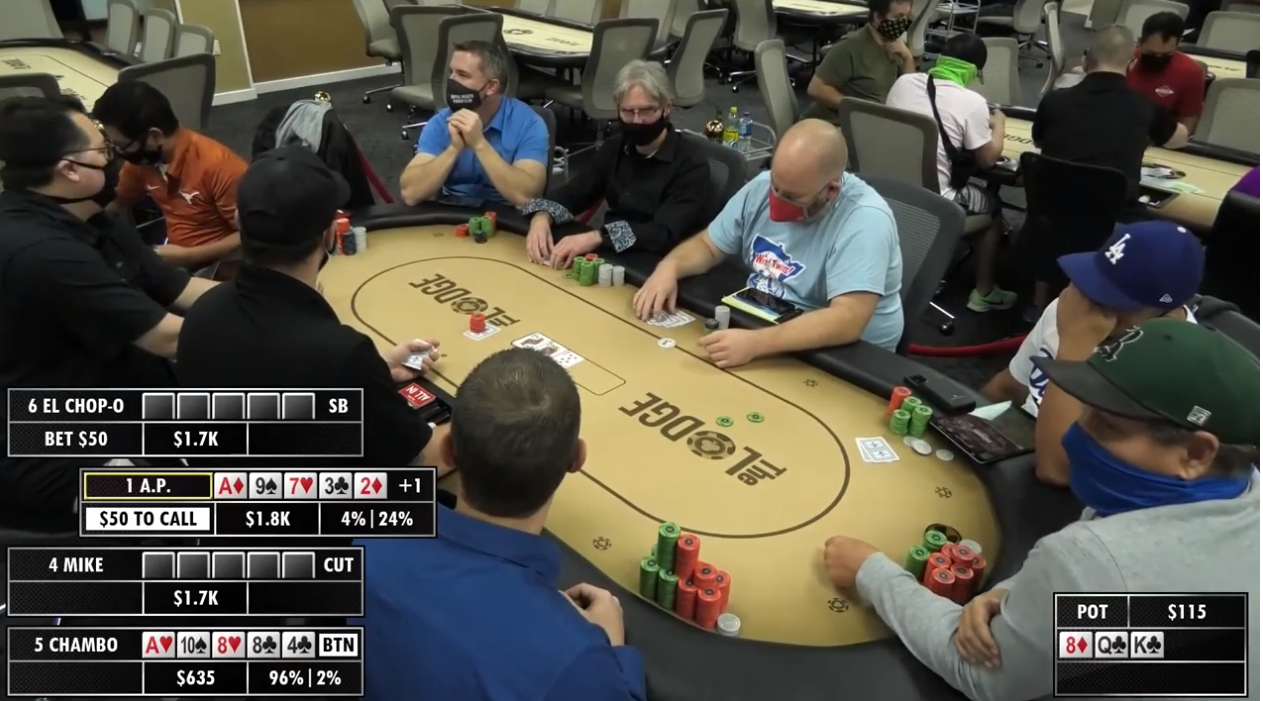When you visit the Lodge Card Club, you’ll notice a game called Big-O on the menu for both cash games and tournaments.
Big-O is a version of Omaha, one of the most popular poker variants played around the world. The rules of Big-O can lead to massive pots and big action, making it a favorite amongst Texas poker players.
Let’s take a look at the game in this Big-O Poker Beginner’s Guide:
What Is Big-O Poker?
Big-O is a poker variant that’s based on the game of Omaha, one of the world’s most popular poker games. The Big-O variant plays as a community card poker game, much like Texas Hold’em.
The rules of Big-O are very similar to Omaha, with one major difference. In Big-O, all players are dealt five hole cards, while in a standard game of Omaha players get four hole cards.
Like Texas Hold’em and Omaha, Big-O games see up to five community cards dealt to the board in each round. Players must use exactly two hole cards and three community cards to make the best five-card hand according to standard poker hand rankings.
Big-O generally plays using hi-lo (split pot) rules, where the best high hand and best qualifying low hand split each pot. Qualifying low hands must not contain a card higher than an eight, and can’t contain a pair, three of a kind, full house, or four of a kind.
Straights and flushes don’t count against low hands. As such, an A-2-3-4-5 straight (aka the wheel) is the lowest possible hand. The highest possible qualifying low hand is the 8-7-6-5-4 straight.
While you’ll see No-Limit Texas Hold ’em and Pot-Limit Omaha games alongside Big-O at the Lodge, it’s important to note that Big-O plays with limit betting rules and as a split-pot game. Pot-Limit Omaha (PLO) games at the Lodge play with pot-limit betting structure, and only the high hand wins each pot.

Big-O Poker Rules
Big-O uses the rules of Omaha, but each player gets five hole cards instead of four. Players must use exactly two hole cards and three community cards to make the best possible five-card hand.
Once each player gets their hole cards, the preflop betting round begins. Beginning with the position on the immediate left of the big blind, each player can either call (match the amount of the big blind), raise (increase the amount of the standing bet), or fold (surrender their hand and sit out until the next hand).
After the preflop round, the dealer puts the first three of five community cards on the board. The first three cards on the board are known as the “flop.”
Another betting round commences after the flop is dealt.
On the flop, and all postflop betting rounds, the first player to act has the option to check, betting nothing and passing the action to the next player. If the first players to act checks, all subsequent players can also check unless one of those players bets.
After the flop betting round, the dealer puts a fourth community card on the board, known as the turn. All live players take part in another betting round after the turn in dealt.
Once the turn round is over, the fifth and final community card is dealt to the board. This card is known as the river, and precedes the final betting round.
After the river betting round, all players still remaining in the hand go to showdown. Keep in mind that Big-O plays as five-card Omaha Hi-Lo (aka Omaha 8), with the best high card hand and the best qualifying low card hand splitting the pot.
To qualify for the low, a player must hold a five-card hand with the high card no higher than an eight. Pairs, three of kind, full houses and four of a kind disqualify a hand from qualifying for the low.
Straight and flushes don’t count against low hands. The lowest hand you can possibly put together in Omaha Hi-Lo is 5-4-3-2-A. This hand is known as the “nut low” and the suits of the cards don’t affect the strength of the hand.


If no player holds a qualifying low hand, the player with best high hand using standard poker hand rankings wins. As will all versions of Omaha, you must use exactly two hole cards and three board cards to make the best hand.
Big-O is one of several different variants of Omaha. The version played at the Lodge essentially plays as five-card PLO8 (Pot-Limit Omaha Hi-Lo with five hole cards).
For an expanded look at the rules of Omaha, check out this guide:
Pot-Limit Omaha Rules Beginner’s Guide
Big-O At The Lodge
The Lodge runs a couple of different Big-O card games around the clock. One is a $1/$2/$5 game with a $200-$1,000 buy-in and match the stack rules. The other is also a $1/$2/$5 match the stack game, but with uncapped bomb pots every orbits.
The $1/$2/$5 amounts represent the amount of the small blind, big blind, and the third blind (the mandatory amount of the first preflop bet).
You can learn more about bomb pots and match the stack rules with the following guides:
What is Match the Stack Poker?
What is a Double Board PLO Bomb Pot?
In both games, you must a minimum of $200 on the table to enter the game. The max buy-in is $1,000, unless any player at the table has more than $1,000. If that’s the case, you can match that stack and buy in for an amount equal to the biggest stack at the table.
The Lodge also occasionally runs $5/$10/$25 PLO/Big-O mixed game, with a $1,000 minimum buy-in and an uncapped maximum buy-in.
Big-O Poker Strategy
Even if you’re familiar with other poker games and other Omaha variants, you should keep a few things in mind when playing Big-O.
With five hole cards, each round begins with many more starting hand card combinations than a No-Limit Hold’em game or even a typical PLO game.
A hand like pocket aces is still a strong preflop holding, but you’ll almost certainly have to improve to win the hand by the river. Very strong hands like quads (four of a kind) become much more likely by the river because of the increased number of possible starting hands.
When playing flush draws, be wary of getting too aggressive with anything less than the nut flush draw. Keep in mind that full houses and better hands are common in Big-O.
Your best starting hands will give you a chance to win both the high and the low in Big-O. If you pile money in with hand that can only win half the pot, you run the risk of getting “quartered,” or splitting the high or low half of the pot with another player that has the same hand.
To learn more about the rules of Omaha split-pot games, check out this guide from Upswing Poker:



